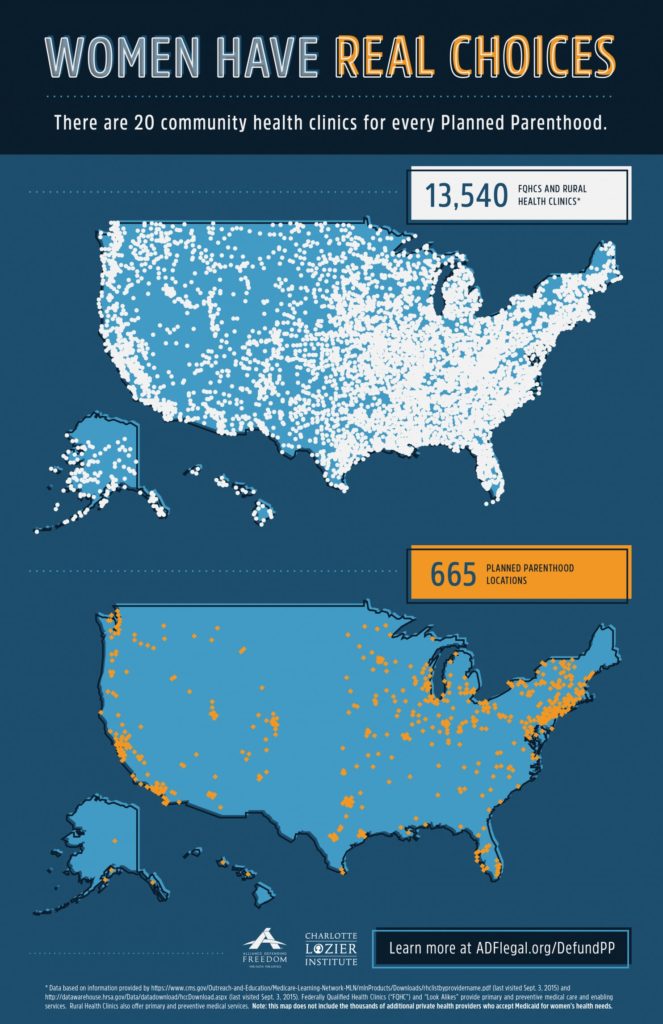Fact Sheet: Reallocating Planned Parenthood’s Federal Funding to Comprehensive Health Centers
To view this fact sheet as a PDF, see: Reallocating Planned Parenthood’s Federal Funding to Comprehensive Health Centers.
In 2015, the Congress of the United States adopted and sent to the President legislation whose effect would have been to reallocate funds from one family planning provider, Planned Parenthood, and redirect those funds to community health centers that typically offer family planning, but do not offer abortions. The goal of separating abortion from contraceptive services has long been a priority in national policymaking. In 2015 as well, Charlotte Lozier Institute, in partnership with Alliance Defending Freedom and other groups listed on the website, devised GetYourCare.org as a means to display the prevalence of these alternative, community-run and community-based providers. Overall, there are now at least 20 of these community providers for every Planned Parenthood clinic in the United States. Because of different word usage and the particular confines of each way of defining alternatives, different ratios can be assigned in discussing these far more prevalent alternatives for women, particularly Medicaid-eligible women. The information below sets out these definitions and why they yield diverse, but nonetheless accurate, ratios for women’s options.
Types of Health Centers
Q: What types of health centers are included in CLI’s national and state maps?
A: There are numerous types of health centers which serve as our nation’s “safety-net,” including but not limited to the following which CLI has included in its national and state map counts: Federally Qualified Health Center (FQHC) Service Sites, Rural Health Clinics (RHCs), and Look-Alikes (LAs). These are also the same health centers on GetYourCare.org.
Q: What are Federally Qualified Health Centers (FQHCs)?
A: Federally Qualified Health Centers (FQHCs) are the main organizations receiving a government grant under the Health Center Program Section 330 of the Public Health Service Act to serve medically underserved areas or populations. FQHCs are required to provide comprehensive services to an underserved area or population, offer a sliding fee scale, have an ongoing quality assurance program, and have a governing board of directors, the majority of whom are patients of the health center. FQHCs are required to provide health care services to patients regardless of their ability to pay, and also must offer transportation assistance as an enabling service.
Q: What are Federally Qualified Health Center (FQHC) Service Sites?
A: Each FQHC may operate multiple health clinics known as “FQHC Service Sites” where healthcare is provided. In order to compare apples to apples, it’s appropriate to compare the number of these actual clinic locations operated by FQHCs to the actual center locations of Planned Parenthood.
Q: What are Rural Health Clinics (RHCs)?
A: Rural Health Clinics are federally funded health centers providing services in areas designated as non-urban and underserved or having a current healthcare shortage. RHCs meet the requirements of Section 330 of the Public Health Service Act and are certified to receive special Medicare and Medicaid reimbursements.
Q: What are Look-Alikes (LAs)?
A: Also known as FQHC Look-Alikes or Health Center Program Look-Alikes, these health centers meet all of the requirements of the Health Center Program including providing comprehensive health care services, but do not receive government grant funding under the Health Center Program. Look-Alikes are, however, eligible for reimbursement through Medicare and Medicaid under similar methodologies as FQHCs; are eligible to purchase discounted drugs through the 340B Federal Drug Pricing Program; and may access National Health Service Corps providers.
Q: Is there any overlap between FQHCs and RHCs?
A: No, health centers that are approved as FQHCs may not be concurrently approved as RHCs, and vice versa.
Q: What are Community Health Centers (CHCs)?
A: “Community health center” is a general term used more broadly to refer to health centers since it is not defined in statute like FQHCs or RHCs. It may also be used to describe a kind of FQHC.
Differences in Cited Numbers of Health Centers
Q: How many Federally Qualified Health Centers (FQHCs) are there currently?
A: There are 1,375 main FQHCs according to the latest Health Center Program Grantee Data published by the Bureau of Primary Health Care. These FQHCs operate multiple health clinics (FQHC Service Sites) at which health care is provided.
Q: How many FQHC Service Sites are there currently?
A: The nation’s FQHCs operate more than 10,500 FQHC Service Sites as of January 2017, according to the Health Resources and Services Administration (HRSA).
Q: How many Rural Health Clinics are there currently?
A: There are 4,134 RHCs as of the most recently updated list provided by the Centers for Medicare and Medicaid Services in September 2016.
Q: How many Look-Alikes are there?
A: There are 244 Look-Alike clinic locations as of January 2017.
Q: What does the count of “1,200 health centers” refer to?
A: This refers to the 1,198 main FQHCs in 2012, as cited in a March 2015 Government Accountability Office report which compared government funding sources of FQHCs and six other organizations including Planned Parenthood Federation of America.
Q: What does the count of “1,300 health centers” refer to?
A: This refers to the 1,278 main Federally Qualified Health Centers (FQHCs) identified by the federal Health Resources and Services Administration (HRSA) and available at the time of CLI’s map production in summer 2015. FQHCs, however, operate numerous health clinics (FQHC Service Sites) where health care services are provided.
Q: What does the count of “9,170 health centers” refer to?
A: This refers to the number of FQHC Service Sites in 2013 operated by the main FQHC as referenced by CLI in our initial national and state-by-state charts in July 2015.
Q: What does the count of more than “10,000 health centers” refer to?
A: This may either refer to the current total number of FQHC Service Sites (10,500) where health care services are provided as of January 2017 or the total number of FQHC Service and Administrative-Only Sites (10,030) at the time of CLI’s map production in summer 2015 according to HRSA. CLI did not include any Administrative Only Sites (564 in summer 2015) in any calculation or map of health centers because these locations do not provide health services.
Q: What does the count of “13,500 health centers” refer to?
A: This refers to the sum of three kinds of health centers: more than 9,100 Federally Qualified Health Center Service Sites, approximately 300 FQHC Look-Alikes, and approximately 4,100 Rural Health Clinics (RHCs) at the time of CLI’s maps publication in the summer of 2015. These are also the health centers that are included in GetYourCare.org.
Q: Where does the ratio, “13 health centers for every one Planned Parenthood,” come from?
A: This refers to the calculation comparing only the 9,170 FQHC Service Sites in 2013 to a high estimate of 700 Planned Parenthood centers as referenced in the March 2015 GAO report.
Q: What is the current ratio of FQHC Service Sites only to Planned Parenthood centers?
A: There are 10,500 FQHC Service Sites and 639 Planned Parenthood centers listed as of January 2017, yielding a ratio of 16 to one.
Q: Where does the ratio, “20 health centers for every one Planned Parenthood,” come from?
A: This refers to the expanded calculation comparing the total of 13,540 health centers (9,100 FQHC Service Sites, 300 Look-Alikes, and about 4,100 Rural Health Clinics) to the 665 Planned Parenthood centers listed on Planned Parenthood’s website as of the summer of 2015.
Q: What is the current ratio of the sum of FQHC Service Sites, Look-Alikes, and Rural Health Clinics to Planned Parenthood centers?
A: There are a total of 14,878 health centers (10,500 FQHC Service Sites, 244 Look-Alikes, and 4,134 RHCs) to 639 Planned Parenthood centers, yielding a ratio of 23 health centers for every one Planned Parenthood. This ratio is helpful for putting into perspective the tens of thousands of low-cost comprehensive healthcare options available for women, though Look-Alikes do not currently receive Health Center Program funding.
Reallocating Government Funds away from Planned Parenthood and towards Federally Qualified Health Centers
Q: Why were Federally Qualified Health Centers included as alternative sources of care for women in the context of defunding Planned Parenthood and reallocating the federal funds?
A: Prior to the production of CLI’s Health Center-Planned Parenthood maps, the Government Accountability Office released a March 2015 report examining the government funding sources of Planned Parenthood Federation of America and five other organizations in comparison to that of the country’s Federally Qualified Health Centers (FQHCs). The report was requested by more than 60 Members of Congress. Following the release of investigative videos in the summer of 2015, Planned Parenthood argued that women’s health care would be severely threatened should it be defunded of its federal money. Recalling the GAO report and seeking to compare apples-to-apples, CLI created an initial series of graphs comparing the 9,170 FQHC Service Sites, actual health clinic locations, to the 700 Planned Parenthood locations.
Q: Why are Rural Health Clinics also included on CLI’s maps?
A: Rural Health Clinics are also an important part of our nation’s federally funded health care safety net serving Americans in specifically rural areas with a health care shortage. RHCs have enhanced reimbursement rates for providing Medicaid and Medicare services.
Q: Why are FQHC Look-Alikes also included on CLI’s maps?
A: We included FQHC Look-Alikes because they have been identified by HRSA and certified by the Centers for Medicare and Medicaid Services as meeting the same requirements of the Health Center Program, including providing primary and preventive care to patients, though they do not receive grant funding under that program.
Q: Under the budget reconciliation language, what alternatives do low-income women have?
A: Under the budget reconciliation draft language, Medicaid-eligible women continue to have full family planning coverage. They can use their Medicaid benefits at any other Medicaid-accepting health care provider. This includes the nearly 15,000 FQHC Services Sites, Look-Alikes, and Rural Health Clinics that outnumber Planned Parenthood by a ratio of at least 20:1. It also includes thousands of Medicaid-accepting physicians’ offices and walk-in clinics. Also under the budget reconciliation draft language, new funding is reallocated to FQHCs. Under this provision more than 10,500 FQHC Service Sites would be eligible to receive funding compared to the 639 Planned Parenthood locations.

























